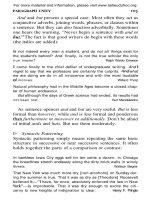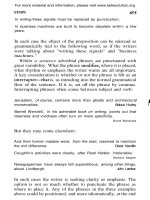Essential guide to writing part 12
Bạn đang xem bản rút gọn của tài liệu. Xem và tải ngay bản đầy đủ của tài liệu tại đây (304.97 KB, 15 trang )
SENTENCE STYLES
forgets the dull routine of army by a romantic
adventure with the heroine:
Maybe she would pretend that was her boy that was killed and
we would go in the front door [of a small hotel] and the porter
would take off his cap and would stop at the concierge's desk and
ask for the key and she would stand by the elevator and then we
would get in the elevator and it would go up very slowly clicking
at all the floors and then our floor and the boy would open the
door and stand there and she would step out and would step out
and we would walk down the hall and would put the key in the
door and open it and go in and then take down the telephone and
ask them to send a bottle of capri bianca in a silver bucket full of
ice and you would hear the ice against the pail coming down the
corridor and the boy would knock and would say leave it outside
the door please.
Both and Hemingway use the sen-
tence to describe an experience taking place within the mind.
The style suggests the continuous flow of dreaming, for we
fantasize in a stream of loosely connected feelings and ideas
and images, not in neatly packaged sentences of intricately
related clauses and phrases tied together by if, but, yet,
therefore, consequently, on the other hand. Indeed, we some-
times fantasize not in words at all but in imagined percep-
tions, as Hemingway implies ("and you would hear the ice
against the pail"). Hemingway also goes further than Gra-
hame in imitating the mental state of fantasy: his one sentence
is much longer and its flow unimpeded by punctuation. This
technique is a variety of what is called "stream of conscious-
ness," a way of writing that suggests a mind feeling, dreaming,
thinking in a loose associational manner.
Multiple Coordination and Parataxis
The Grahame, Hemingway, and biblical examples all use mul-
tiple coordination, linking clauses by coordinating conjunc-
these cases, as in most, by using the word
For more material and information, please visit www.tailieuduhoc.org
THE SENTENCE
Instead of being coordinated, however, independent clauses
can be butted together without conjunctions, in which case
they are conventionally punctuated by semicolons, though
sometimes commas are clear enough. This is called parataxis.
Although either multiple coordination or parataxis is pos-
sible in a freight-train sentence, they are not exact equivalents.
Broadly speaking, the is called for when the ideas or
feelings or perceptions are when the writer
desires a quick and fluid movement from clause to clause.
These conditions are true of the three examples we have just
seen, as they are of the following relatively short sentence by
Hemingway:
It was a hot day and the sky was bright and the road was white
and dusty.
There is movement here, involving both the scene and the
sense by which we perceive it: we feel the heat, see the sky,
lower our eyes to gaze down the road. The sentence style
directs our senses much as a camera directs them in a
guiding us from one perception to another, yet creating a con-
tinuous experience. The freight-train style, then, can analyze
experience much like a series of segregating sentences. But it
brings the parts more closely together, and when it uses mul-
tiple coordination, it achieves a high degree of fluidity.
On the other hand, fluidity is not always desirable. Ideas
or perceptions may be repetitive, with little change and noth-
ing to flow together. Then parataxis is preferable to multiple
coordination. In the following example Virginia sum-
marizing a diary of an eighteenth-century Englishman visiting
France, uses a freight-train style to mock his insularity:
This is what he writes about, and, of course, about the habits of the
natives. The habits of the natives are disgusting; the women hawk
on the floor, the forks are dirty; the trees are poor; the Pont Neuf is
not a patch on London Bridge; the cows are skinny; morals are
licentious; polish is good; cabbages cost so much; bread is made
of coarse flour.
For more material and information, please visit www.tailieuduhoc.org
SENTENCE STYLES
Each detail is another instance of the same underlying insen-
sitivity. By hooking her clauses with semicolons (in one case
with a comma) Woolf stresses the dull, unyielding vision of
the diarist.
Along with its advantages, the freight-train sentence has
limitations. Like the segregating style, it does not handle ideas
very subtly. The freight-train sentence implies that the
thoughts it links together with grammatical equality are
equally significant. But usually ideas are not of the same order
of importance; some are major, others secondary. Moreover,
this type of construction cannot show very precise logical
relationships of cause and effect, condition, concession, and
so on. It joins ideas only with such general conjunctions as
and, but, or, nor or even less exactly with semicolons and
commas.
The Triadic Sentence
A second deficiency of the freight-train sentence is that it
lacks a clear shape. Being open-ended, it has no necessary
stopping place; one could go on and on adding clauses. As a
way of providing it with a clearer structural principle, the
freight-train sentence is sometimes composed in three units
and is called a triad:2
Her showmanship was superb; her timing sensational; her dramatic
instinct uncanny.
Business executives, economists, and the public alike knew little of
the industrial system they were operating; they were unable to di-
agnose the malady; they were unaware of the great forces operating
beneath the Arnold
Often, as in these examples, the three clauses are paratactic
rather than coordinated because the triadic sentence tends to
2. These sentences are also called tricolons. Loosely, colon designated in an-
cient Greek rhetoric an independent clause that was part of a longer sentence.
A is a sentence of three such clauses.
For more material and information, please visit www.tailieuduhoc.org
THE SENTENCE
be repetitive. But it can use conjunctions when shifts in sub-
ject occur:
Then the first star came out and the great day was over and in the
vestibule saw my grandmother saluted by her sons who wished
her a happy holiday.
In sentence the final clause is substantially longer
than the two that precede it. Movement to a longer, more
complicated construction is a refinement of the triadic
sentence:
The canisters were almost out of reach; made a motion to aid her;
she turned upon me as a miser might turn if anyone attempted to
assist him in counting his money. Emily Bronte
Occasionally the shift may work in the opposite direction,
from long to short:
Calvin Coolidge believed that the least government was the best
government; he aspired to become the least President the country
ever had; he attained his desire. Irving stone
The Cumulative Sentence
Most commonly a cumulative sentence consists of an initial
independent clause followed by a number of subordinate con-
structions which accumulate details about the person, place,
event, or idea. Though the elements that come after the main
clause are technically subordinate, they carry the main load
of the sentence and are fully as important.
Cumulative sentences appear most often in description.
The writer begins with a general picture, like an artist's char-
coal sketch, then fills in the details:
A creek ran through the meadow, winding and turning, clear water
running between steep banks of black earth, with shallow places
where you build a dam.
For more material and information, please visit www.tailieuduhoc.org
SENTENCE STYLES
7000 Romaine St. looks itself like a faded movie exterior, a pastel
building with chipped arte moderne detailing, the windows now
either boarded up or paned with chicken-wire glass and, at the
entrance, among the dusty oleander, a rubber mat that reads
WELCOME. Joan Didion
Cumulative sentences are also useful in character sketches:
She [Anne Morrow Lindbergh] was then twenty-one, a year out of
Smith College, a dark, shy, quiet girl with a fine mind and a small
but pure and valuable gift for putting her thoughts and fancies,
about the earth, sky, and sea, on paper. John Lardner
Though less often used in narration, the cumulative sen-
tence can also handle a series of events, as in this account of
an English military expedition into France in 1359:
The unwieldy provision carts, draught horses, and heavily armed
knights kept the advance down to nine miles a day, the huge horde
moving in three parallel columns, cutting broad highways of litter
and devastation through an already abandoned countryside, many
of the adventurers now traveling on foot, having sold their horses
for bread or having slaughtered them for meat. John Gardner
Like the freight-train style, the cumulative has the problem
of being open-ended, without a natural stopping place. But
the deficiency may be made good by artful construction. In
the following example the writer, a photograph of
his parents, opens with the clause "When they sat for a pho-
tograph together," follows this with accumulated details, and
ends by assessing the meaning of the picture:
When they sat for a photograph neat slim bodies,
the girl unsmiling and her eyes astare, elbows and knees tight,
hands clenched in her lap, immaculate to the throat in lacy white,
and the young man with grin and straw hat both aslant, jaunty
on the bench arm, one leg crossed, natty in his suit and tie com-
plete with stickpin, his arm around her with fingers outspread
For more material and information, please visit www.tailieuduhoc.org
THE SENTENCE
possessively upon her was a portrait not only of con-
trasts, but of a nation's lower middle class coming out of its
COCOOn. William Gibson
What happens in that sentence is that the accumulation is
gathered between dashes and intrudes into the middle of the
main sentence ("When they sat for a photograph together ...
it was a portrait not only of contrasts, but of a nation's lower
middle class coming out of its cocoon"). That sentence be-
comes a frame enclosing the details, a pattern nicely suited to
what the sentence is about.
Finally, there is another variety of the cumulative sentence,
in which the order is reversed: the accumulated details precede
the main clause instead of following it. In the following ex-
ample a novelist, discussing her art, begins by listing the es-
sentials of a story.
Conflicts and rivalries and their resolutions, pride and its fate, es-
trangement and reconciliation, revenge or forgiveness, quests and
searches rewarded or unrewarded; abidingness versus change, love
and its are among the constants, the themes of the
Story. Elizabeth
Notice how Bowen uses these to sum up all the preceding
nouns and to act as the subject of the sentence. (These, this,
that, those, and such are other pronouns which may be used
in this way.)
For Practice
Describe one of your typical days, first in five or six segregating
sentences, then in two freight-train sentences, and finally in one
long cumulative sentence. Keep to the same details and order in
each rendering.
The Parallel Style
Parallelism means that two or more words or constructions
stand in an identical grammatical relationship to the same
For more material and information, please visit www.tailieuduhoc.org









